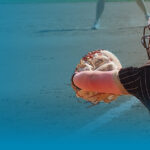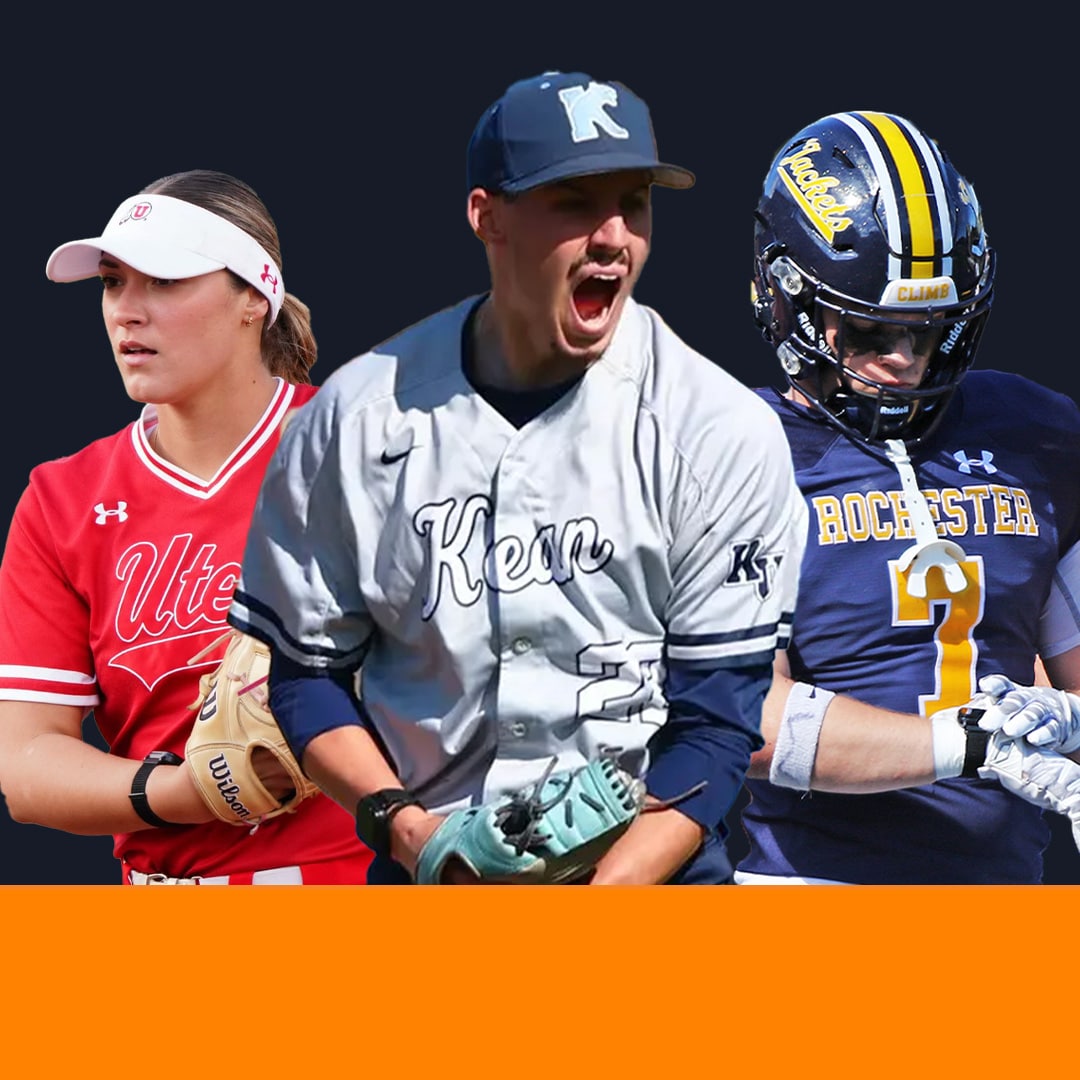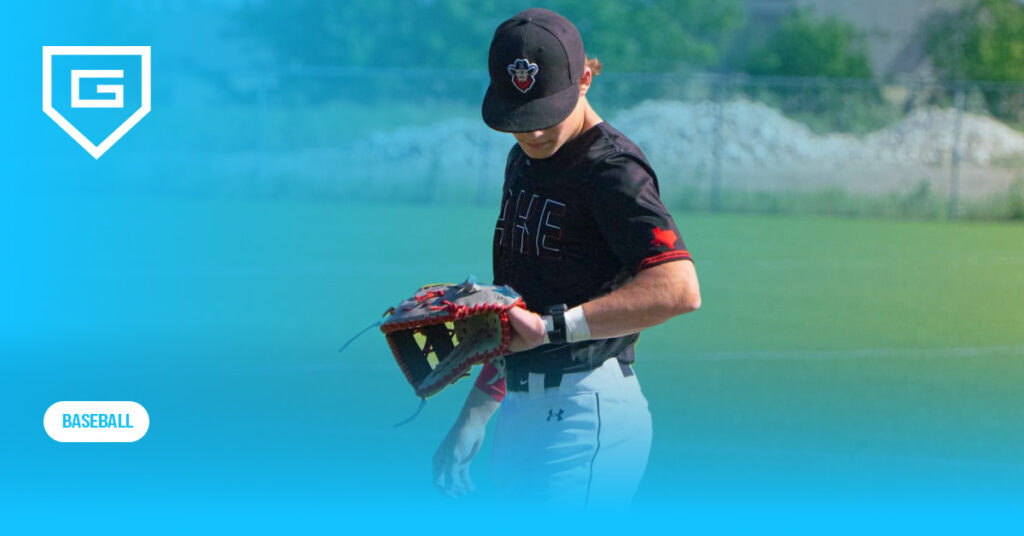Electronic Pitch Calling System: The Ultimate Buyer’s Guide for 2025
Reading Time: 12 minutes
Reading Time: 12 minutes
Whether you coach high school, college or travel ball, electronic pitch calling systems allow you to send signals from the dugout to your pitcher or catcher, making team communication faster, clearer and more secure than ever.
Forget miscommunication or stolen signs.
This guide will walk you through how to choose the right electronic pitch calling system for your team. You’ll see how it works, why more teams are using this cutting-edge technology and what rules to know before you bring one to your field.
Key Takeaways
- Electronic pitch calling improves team communication and reduces missed signals.
- Support apps let coaches manage signals and update plays easily.
- Wearable receivers get pitch calls to players on the field instantly.
- Encrypted systems prevent sign stealing and keep calls secure.
- Devices work without WiFi and in any weather.
- Setup is quick, easy and user-friendly.
- Systems are approved for use in high school, college and professional leagues.
- Teams can customize packages based on size, budget and league rules.
- Devices are built to last with long battery life and rugged design.
- Pricing starts at $650 and scales with the number of devices needed.
- Adoption is growing; most top programs are already using the technology.
- Future updates will have AI-driven suggestions and real-time analytics.
- The biggest challenges are syncing issues, battery management and user resistance.
- When used correctly, electronic pitch calling systems give a huge strategic advantage.
GoRout Diamond is the top electronic pitch calling system for its rugged weatherproof design, reliable signal transmission, and fully customizable team packages.
Trusted by top programs and built for real game conditions, it delivers unmatched clarity, speed and durability on the field.
Visit the web shop or get a quote today.
What Is An Electronic Pitch Calling System?
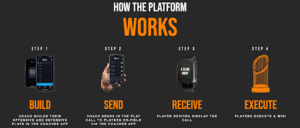
An electronic pitch-calling system is a secure wireless solution that allows coaches to send real-time pitch selections or defensive calls to players, usually through a wearable device.
This game-changer makes communication faster and harder for other teams to steal your signs.
As a head coach, you use a small keypad or mobile device to select the pitch or play. The system sends this selection securely to a receiver, like a wristband or earpiece, worn by the catcher or other player. They get the call on their device and execute the play.
This durable technology ensures accurate and timely communication during critical game situations.
We used GoRout to call pitches, defensive plays, pickoffs and offensive plays. Our players did not miss a sign this season and we did not have to worry that the other team was stealing our signs. – Coach Brooks Kerr, Calvert Hall College High School
How Has Electronic Pitch Calling Technology Evolved Over Time

Calling pitches has changed from simple hand signals to fast digital systems that streamline the game and enhance team communication.
Key milestones:
| Year | Milestone |
| 2022 | MLB introduced electronic pitch-calling devices in games, letting pitchers receive signals wirelessly to prevent sign-stealing and speed up play. |
| 2023 | MLB let pitchers use electronic wristbands to select pitches themselves, while high school baseball (NFHS) also allowed electronic pitch-calling. |
| 2024 | The initial launch of one-way communication devices in NCAA baseball was in 2021.
In 2024, the NCAA expanded the use of one-way electronic devices in college baseball – allowing players on the field or coaches in the third base or first base boxes to initiate one-way communication and relay signals to offensive or defensive players. |
Among the latest advancements, GoRout Diamond has emerged as a top choice—especially for NCAA-approved play.
It offers secure, instant communication between coaches and players without needing WiFi. Baseball and softball teams can play faster, stay coordinated, and prevent sign-stealing.
It comes with a rugged design for any weather, customizable team setups, and user-friendly software, making it both reliable and efficient.
If your team needs a professional-grade solution that performs under pressure, GoRout Diamond is absolutely worth considering.
What Are The Key Components Of Electronic Pitch Calling Systems?
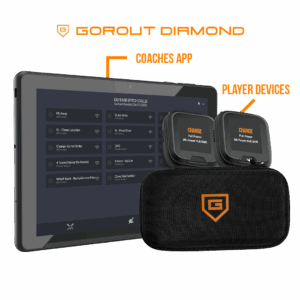
Signal management and setup happen through specialized software or coach-friendly apps. You can program signals, manage devices, and push updates.
Sending calls starts with a coach-operated controller or mobile app. You can use multi-button interfaces or touch screens to select pitch types, defensive alignments, or signals for any game situation.
Receivers are the devices players use to get your signals. They come as watches, electronic wristbands, or can be tucked into a helmet or glove.
Some show clear displays, others use audio or vibrations—so nothing’s missed even in loud stadiums or harsh weather.
Most systems rely on cellular networks for fast and secure communication.
GoRout Diamond, powered by GoRout Air™, goes one step further and uses Licensed LTE nationwide through a partnership with KORE Wireless. It enables instant, reliable play data transfer on the field—no syncing, routers, setup, or WiFi needed.
What Are The Key Features Of An Electronic Pitch Calling System?
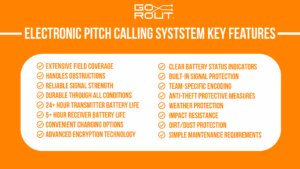
Here’s what to look for when selecting an electronic pitch calling system for your team.
| Feature | Details |
| Field coverage | Signal reaches up to 180 yards in open field |
| Obstruction handling | Works reliably through dugouts, fences, and crowds |
| Signal strength | Maintains strong connection across all field positions |
| Testing data | High reliability in rain, noise, and crowded conditions |
| Transmitter battery life | Lasts 24+ hours of active use—covers multiple games |
| Receiver battery life | Runs 5+ hours per charge—enough for full game use |
| Charging options | Fast charging between innings or overnight |
| Battery indicators | LED or app-based battery status notifications |
| Encryption technology | End-to-end encryption with advanced security layers |
| Signal protection | Built-in tech to prevent signal hacking or cross-talk |
| Team-specific encoding | Custom codes to ensure only your team receives the signals |
| Anti-theft measures | Lock or disable devices remotely if lost or stolen |
| Weather protection | Operates in rain, heat, and sub-zero temps without issues |
| Impact resistance | Withstands drops, hits, and rough use during games |
| Dirt/dust protection | IP-rated to block out dust, sweat, and debris |
| Maintenance requirements | Wipe clean; no special care needed |
If you’re looking for an advanced system that meets all these needs, GoRout Diamond delivers with four-way privacy screens, encrypted signal transmission, AI analytics, all-weather durability, and extended battery life—without relying on WiFi or extra hardware.
This sports coaching technology is built for real games, letting you customize everything for your coaching style and team needs.
Visit our web shop or get a quote today to see how GoRout Diamond can boost your team’s game-day communication.
How An Electronic Pitch Calling System Compares to Traditional Methods
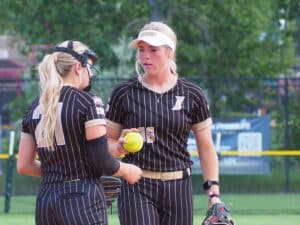
Traditional hand signs can work, but they’re slow and easy for other teams to steal, especially in big stadiums or bad weather. New players often need extra time to learn complicated sign systems, which makes it tough to adapt quickly.
Electronic systems, like GoRout Diamond, help players and teams avoid mistakes from misreading signs, keeping everyone on the same page. These devices work in all weather conditions, so they’re a wise choice all season.
Here’s a head-to-head comparison.
| Feature | Electronic System | Traditional Method |
| Communication speed | Instant | Slower |
| Sign stealing risk | Very Low | High |
| Weather impact | Minimal | Can be severe |
| Learning curve | Simple for new players | Steep |
| Error rate | Low | Higher |
| Strategic flexibility | High | Limited |
| Adaptation for new players | Easy | Challenging |
| Costs | More expensive | Little to none |
Using electronic pitch calling is now common for teams at all levels of baseball and softball. It helps keep the game smooth, quick, and secure—it’s hard to imagine going back.
What Are The Benefits Of An Electric Pitch Calling System?
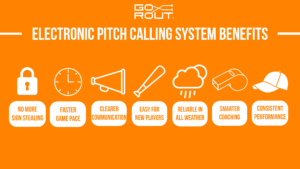
Electronic pitch calling systems have many benefits for baseball and softball teams, giving them a competitive edge. Here’s how GoRout Diamond changes how coaches communicate with players and helps you deliver real results:
- No more sign stealing: With GoRout Diamond’s encrypted, team-specific signals, your defensive shifts, offensive strategy, and pitch selections stay secure so opponents can’t steal signs.
- Faster pace: GoRout’s instant digital delivery cuts down delays, allowing coaches to communicate directly and send defensive plays without mound visits or hand signals.
- Clearer communication: GoRout’s wearable displays eliminate confusion with direct, easy-to-read instructions—no more missed or misunderstood calls.
- Easier for new players: GoRout simplifies onboarding—new athletes can follow clear visual cues instead of memorizing complex sign systems.
- All-weather reliability: Built for tough conditions, GoRout Diamond performs in rain, heat, and cold with rugged hardware and bright screens.
- Smarter coaching decisions: GoRout’s app-based interface lets coaches adjust plays on the fly, send position-specific instructions, and sync across the team in real time.
- Consistent, game-ready performance: The system maintains smooth, uninterrupted communication—even in noisy, high-pressure environments—keeping everyone on the same page.
GoRout Diamond brings all these benefits together in one proven, coach-friendly platform—built for game day and trusted by competitive teams nationwide.
Visit the webshop or get a quote today.
GoRout has enhanced our program, communication and the chance to win more than ever before. We are proud to partner with GoRout and the best service team around in the game. – Coach Aaron Klotz, Adrian College
How Do You Implement An Electronic Pitch Calling System?
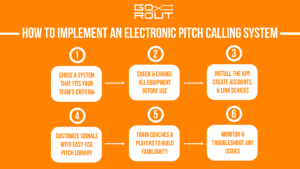
Implementing an electronic pitch calling system requires planning with a few simple steps to ensure smooth real-time coach-to-player communication.
- Choose a system that fits your team size, budget, and future growth.
- Check and charge all equipment before use.
- Install the app, create accounts, and link devices.
- Customize signals with an easy-to-remember pitch library.
- Train coaches and players with meetings and practice drills to build familiarity.
- Monitor syncing, battery, and signal issues; include troubleshooting in practices.
Starting early in the season maximizes benefits and improves team performance on game day.
Case Studies: GoRout Diamond’s Success Stories
BC Fastpitch 16U
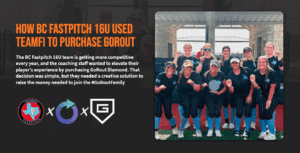
The BC Fastpitch 16U softball coaching staff wanted to provide their team with a higher level experience. They decided GoRout Diamond was the right solution to help streamline their preparations and allow players to focus on execution during tournament play.
BC Fastpitch 16U utilized TeamFi’s user-friendly fundraising interface to raise $4,380 — nearly double their goal — for the devices. The team enjoyed the benefit of advanced communication and organization on the diamond with GoRout’s electronic pitch calling system.
Central Arkansas
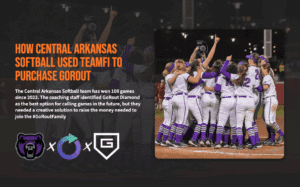
The Central Arkansas University Softball team already help a .640 winning percentage since Jenny Parsons became head coach, but she and her staff identified a need for enhanced efficiency.
Coach Parsons and her staff landed on GoRout Diamond. The customizable nature and variety of solutions it brings to the game made it an easy choice. In just 14 days, the team raised $9,000 through TeamFi fundraising. Now they can build on their already impressive success with the help of GoRout’s electronic pitch calling system.
How Much Does An Electric Pitch Calling System Cost?

Prices for electronic pitch calling systems vary, mostly based on how many players you need to equip and which features you want.
Most systems bundle hardware, network access, and support into the total price—sometimes even including a coach’s tablet or setup assistance.
GoRout Diamond offers transparent, team-friendly pricing. Here’s a simple breakdown to help you estimate costs based on your roster and setup needs.
Each package comes with a charging station, GoRout Air™ network, one-year lease contract, unlimited coaching seats and a coaching mobile app. All devices are backed up with a 100% breakage warranty.
When you look at the price, don’t just focus on the device. There could be extra fees for more devices, upgrades, or contract renewals at the end of your lease. Always double-check what support and updates you’ll get after the first year.
To help cover costs, many teams turn to booster clubs, school budgets, or local sponsors. Comparing features and support in each system is worth the time before you make a decision.
What are the Regulatory Compliance Requirements?
Before you buy an electric pitch calling system you need to know the main rules. Rules keep your system legal, secure, and approved for play.
MLB regulations and guidelines
Major League Baseball (MLB) allows electronic pitch-calling systems if the technology provides one-way communication. It can’t be used to transmit any other information or signals.
The league must approve the devices, and all teams must have equal access to the technology. MLB monitors for misuse and prohibits any form of two-way communication.
NCAA compliance information
The NCAA permits electronic pitch calling systems, but only for one-way communication from the dugout to the field.
GoRout Diamond is approved, and usage is strictly regulated to prevent any competitive advantage or rule violations.
High School Federation guidelines
The National Federation of State High School Associations (NFHS) approved the use of a one-way coach to catcher electronic communication.
The system must only be used for pitch calling, and all communications must comply with NFHS rules to ensure fairness.
What are the Future Trends in Electronic Pitch Calling Systems?

The future of electric pitch calling is smarter and more connected.
Integration is the big trend right now. Systems will soon connect with pitch tracking and analytics tools so you can see pitch choices, speeds, and spin rates together.
Live video feedback will let teams watch calls and analyze responses in real-time. These connections will help everyone spot patterns faster and adjust mid-game.
Wearable tech is moving fast. Devices are getting smaller and lighter, so they’re less of a distraction. Batteries are lasting longer and charging faster, which is a relief during a long baseball season.
Designs are becoming more comfortable, and some models are being adapted for softball, so you can use the same gear across sports.
Artificial intelligence is entering the picture. New systems are using AI-powered algorithms to suggest pitches and spot opponent patterns. Over time, AI will help with game planning and even predictions, giving teams a real edge.
What Are The Common Issues With Electronic Pitch Calling Technology?
Electronic pitch calling systems improve your team’s communication, but some of them come with issues. It’s good to know these ahead of time so you can plan and avoid headaches during the season.
Technical issues and troubleshooting
You’ll run into glitches like lost connections, battery failures, or delays in messages. These can slow down games or make you go back to old-school methods.
- Devices won’t sync up.
- Weather—rain or extreme heat—can mess with device performance.
- Earpieces and wristbands can run out of battery in the middle of play.
Player and coach adoption barriers
Getting everyone used to the system takes time. Some players and coaches aren’t sure about new tech and think it’s a distraction.
- It takes practice and patience to learn the system.
- Some people, especially older coaches or players, just prefer traditional signs.
- Software updates can be a pain, especially during a busy season.
Game situation management
Using the tech in high-pressure situations can be tough. Fast play, loud crowds, or sudden strategy changes can make digital signals hard to use or follow.
- Miscommunication can still happen if a player gets the wrong signal.
- Audio glitches or device lag can disrupt quick plays.
- Coaches need a backup plan in case devices fail mid-game.
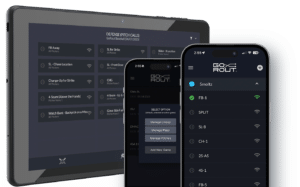
GoRout Diamond solves these common problems with reliable, game-tested technology.
Its rugged, weather-resistant hardware holds up in extreme conditions, while long battery life and secure wireless syncing reduce in-game failures.
The system is simple to learn, with an intuitive coach app and clear visual displays that make adoption easier—even for those new to tech.
With real-time updates, customizable signals, and built-in troubleshooting tools, GoRout Diamond helps your team stay focused, fast, and fully connected.
Ready to upgrade your team’s communication? Visit our web shop or get a quote today.
GoRout has made pitch calling for our staff of 8 so much easier. The days of having signs picked or cutting out number cards are over. We can easily customize the pitches for each of our pitchers and include everything we need! – Coach Morgan Zerkle, Marshall University
Conclusion About Electric Pitch Calling Systems
Electronic pitch calling systems are becoming the standard for baseball and softball teams wanting clear, fast, and secure in-game communication.
You can reduce sign-stealing, speed up play, and help players stay focused using these modern tools.
With many systems now approved for use in high school, college, and tournaments, you have more choices than ever.
Picking the right system means checking for reliability, security, and battery life. Make sure any device works smoothly in tough weather and fits your budget.
For top solutions, see what GoRout offers or check out the official web shop. It is your next step toward reliable and effective team communication.
FAQs About Electric Pitch Calling Systems
How does electronic pitch-calling work?
Electric pitch-calling lets coaches send signals to players using wireless devices. A coach might press a button or use an app that sends an audio or visual signal to a player’s earpiece, headset or wristband.
What is the electronic pitch-calling in the MLB?
In Major League Baseball, electronic pitch-calling systems allow coaches and catchers to communicate securely with pitchers and fielders via a radio device. It prevents sign-stealing and speeds up games.
What is the electronic device for pitchers?
Pitchers wear small audio receivers usually tucked into their caps or clipped onto their belts. These little gadgets play the pitch call loud and clear so pitchers can hear the instructions without any hand signs. Only approved devices are allowed in official games.
What is a pitch call?
A pitch call tells the pitcher what type of pitch to throw—like a fastball or curveball. Coaches and catchers used to rely on finger signals, but now they can just send the call electronically.
How does the electronic pitch-calling system improve game speed and security?
Electric pitch-calling speeds things up a lot. Direct digital signals mean you skip the old hand signs, which cuts down on confusion and delays.
These systems use strong encryption so outsiders can’t easily decode or steal the signals. That’s a big relief for teams worried about security.
Why are professional leagues trusting these electronic pitch-calling solutions?
Pro leagues choose these systems because they reduce sign-stealing and keep games moving. Secure communication matters, and trusted options like GoRout Diamond have handled millions of signals with no reported breaches at the top levels.
In what ways do encrypted signals enhance game security against cheating?
Fully encrypted signals keep the pitch calls private. With encryption, no one can crack or intercept the signals.
Your team’s secrets are safe from opponents. No one has ever stolen a signal with an encrypted system.



